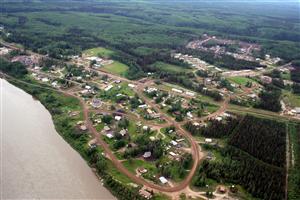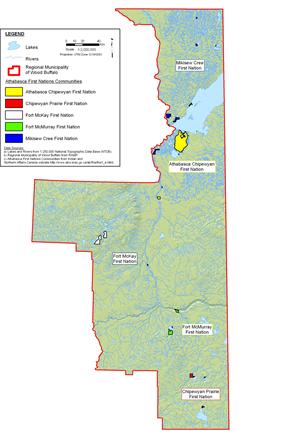Aboriginal Communities in the Regional Municipality of Wood Buffalo today
Today, there are five First Nations communities within the RMWB. They include: Mikisew Cree First Nation, Athabasca Chipewyan First Nation, Fort McKay First Nation, Fort McMurray No. 468 First Nation and Chipewyan Prairie Dene First Nation. Métis peoples are represented by six Métis Locals.
Mikisew Cree First Nation
Mikisew Cree First Nation is the largest First Nation in the RMWB with over 2,500 registered members. MCFN has nine reserves located north of Lake Athabasca and in the Peace-Athabasca Delta. The most populated reserves are the Dog Head and Allison Bay reserves near Fort Chipewyan, AB. Two other sizable reserves are located at Peace Point on the Peace River, and on the Athabasca River near the southeast corner of Wood Buffalo National Park (INAC website 2006a, MCFN website 1999).
Athabasca Chipewyan First Nation
The K’ái tailé Dene became Athabasca Chipewyan First Nation with the signing of Treaty 8 in 1899. ACFN Chief Laviolette made the first formal request that reserve lands be set aside for the exclusive use of ACFN members in 1922 (ICC 1998a). It was not until 1954 that ACFN IR 201 was “officially established” (ICC 1998a). ACFN currently has eight reserves in the Athabasca Delta and on the south shore of Lake Athabasca.
Fort McKay First Nation
Fort McKay residents are of Dene, Cree and Métis ancestry (FMFN 1994). The Dene living in Fort McKay are closely related to K’ai tailé Dene in Fort Chipewyan and other Dene peoples in the Athabasca region (Coutu and Hoffman-Mercredi 2002). With the addition of 9,308 ha of Treaty Land Entitlement reserve lands in 2006, Fort McKay First Nation now has seven reserves (INAC website 2006b). Reserve lands are located across the river from and surrounding the community of Fort McKay. Two reserves are located in the Birch Mountains along the shores of Buffalo (Namur) and Moose (Gardiner) Lakes. In December 2007, Fort McKay had 630 registered members, with about half of them living off reserve (INAC website 2006a).
Fort McMurray468 First Nation
Fort McMurray First Nation traces its ancestry to the Woodland and Plains Cree and also the Chipewyan and Beaver people of Alberta (FMcFN 2006). Fort McMurray First Nation signed adhesion to Treaty 8 in 1899, after which time the band was referred to as the “Cree-Chipewyan Band of Fort McMurray”. The band has four reserves. The Clearwater Reserve is located about 20 km east of Fort McMurray. The other three are located near Anzac on Gregoire Lake, approximately 50 km southeast of Fort McMurray. Gregoire Lake Reserve is the largest and most populated. The majority of Fort McMurray First Nation band members (68 percent) live off-reserve in Fort McMurray.
Chipewyan Prairie Dene First Nation
Chipewyan Prairie Dene First Nation is comprised of Athabascan (Dene) speaking people who live in the community of Janvier situated 100 km southeast of Fort McMurray. Many of the original families who formed this community came from the Garson Lake and Lac La Loche area of Saskatchewan. This First Nation has three reserves located in Janvier, on Cowper Lake and on Winefred Lake. About 300 members currently live on the reserve in Janvier. Chipewyan Prairie was the last band to sign Treaty 8 in 1922 (Chipewyan Prairie Dene First Nation 2005).
Métis Locals in the RMWB
The Métis Nation of Alberta (MNA) is formally organized into six regions, with each region containing a number of registered Métis Locals. The RMWB lies within MNA Regions I and V, and includes Locals 125 (Fort Chipewyan), 63 (Fort McKay), 1935 and 2020 (both in Fort McMurray), 780 (Anzac), and Local 193 (Conklin).










